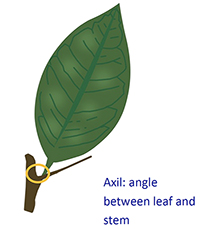Lebbeck Mealybug
Life Stages
Mated females will produce hundreds of eggs in her lifetime. These eggs develop into crawlers, which are mobile nymphs (offspring). Nymphs resemble, and are easily confused for, scale nymphs. They are very small, reddish-purple, and have legs and antennae that are visible under magnification.
The adult male is 1.3-2.5 mm long is brown-purple. It has well developed front wings.
The female has three nymphal stages and slowly moves between stages to new feeding sites. The adult is oval, reddish-purple and is 2.4-4 mm long and 1.5-3 mm wide. Once the female begins laying eggs, it develops a white-pale yellow ovisac (egg sack) that houses tiny red eggs and is covered in wax. A female produces approximately 1,000 eggs in her lifetime. In the Middle East, the female is known to live up to 50 days and die shortly after laying all of her eggs.
Spread
Crawlers are very small and can easily be moved on people, animals, farm tools (like pruning shears), farm equipment (trucks, sprayers, tractors), the wind, and are even purposefully moved by ants to new hosts. In other countries, ants have been found farming these mealybugs for their honeydew and serve to protect them from predators.

Scouting
N. viridis prefers to feed on rapidly growing plant material. On fruit, it is most commonly found on the calyx button (area where fruit is attached to stem), but can be anywhere on fruit surface. It prefers new flush and feeds in the axil (angle area between leaf and stem) and branch junctions.
Common Misidentification
The N. viridis ovisac is commonly mistaken for cottony cushion scale ovisac. They are distinctly different in appearance. N. viridis is disorganized, clumpy, and looks dirty; whereas, cottony cushion scale is organized, has long ridges, and is a clean, white color.
Damage
The damage and feeding sites are distinct from other wax-producing pests (mealybugs and scales), which it has been mistaken for in several fields. N. viridis prefers to feed and reproduce on fast growing tissues like new growth, new branches, and fruit. Fruit feeding causes hardened lumps and/or discoloration. Leaves also become twisted/distorted from feeding.
Fruit drop is the biggest factor in crop loss. In South Africa, fruit drop has caused 50% or more crop loss. The fruit damage is distinct and makes the fruit unsightly and unmarketable for fresh fruit markets.
Grove Management
Management for N. viridis in Florida is yet to be determined. In its home region, predatory insects (wasps, lady beetles, lacewings) can largely keep populations in check. However, if the populations of predatory beneficial insects are reduced, for example, by broad spectrum insecticides, the lack of predators will allow large populations to build up.
Like all insects that feed within a protected space, adults will be hard to eradicate. Timing for insecticidal actions to crawler activity, much like that done for scale populations, will be key to control.
Human Precautions
Because this pest is easy to move unintentionally, it is highly recommended to sanitize all materials that may have come into contact with them to prevent spread. Power wash large equipment, sanitize smaller tools with a combination of bleach and water before moving to a new grove.
If moving between groves, it is suggested to change clothes and wipe exposed skin surfaces.
Links
Plant Pests of the Middle East
Nipaecoccus viridis (Newstead), Lebbeck Mealybug, (Coccoidea: Pseudococcidae), Updated Pest Alert
